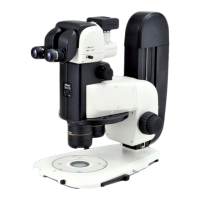Chapter 7 Specific Operations
82
13.2
Selecting a Filter Cube
The epi fluorescence attachment can be equipped with the following filter cubes:
• P2-EFL GFP-B, P2-EFL GFP-L, and P2-EFL RFP Filter Cube: Used for fluorescence observation with a given wavelength.
• P2-EFLC Filter Cube: Used for fluorescence observation with an arbitrary wavelength when combined with arbitrary filters,
for example.
• P2-EFLBFA Filter Cube (Bright Field): Used for bright-field episcopic observation.
• Empty cubes (three cubes supplied with an epi-fluorescence attachment): Used when performing diascopic illumination
observation using the epi-fluorescence attachment.
13.3
Important Notes for Epi-Fluorescence Microscopy
Using non-fluorescent slide glass and cover glass
When performing fluorescence observation of samples with a slide glass or cover glass, be sure to use non-fluorescent
slide glass or cover glass to obtain a high-contrast image.
Locating a target in the sample
For epi-fluorescence microscopy, Nikon recommend locating a target with bright-field diascopic illumination (OCC
illumination) and then switching to epi-fluorescence rather than emitting strong excitation light to the sample from the
beginning. When doing so, follow the operational tips below:
• Start with low magnification under bright-field diascopic illumination.
• If the sample is not transparent, use the P2-EFLBFA Filter Cube (Bright Field) to obtain the entire image by reflected light.
• Gradually increase the magnification. When the target becomes difficult to locate, switch to epi-fluorescence and use
low excitation light.
CAUTION
Protection from ultraviolet light (light shielding plate)
The light shielding plate is used to prevent the reflected ultraviolet
light, which is originally emitted through the objective, from entering
the observer’s eyes from the sample.
Using the light shielding plate
14
Remote Operation
The microscope system enables remote control of several functions including focusing and changing magnification. The
following remote control devices can be used when connected with the P2-CTLA Control Box:
• P2-RC Remote Controller
• AZ-FSW Foot Switch
• AZ-PCR Photo Release
For details, see Chapter 8, “10 Remote Control Devices.”
Remote control from NIS-Elements is also possible by connecting the USB connector on the control box to a personal
computer. For details, refer to the NIS-Elements instruction manual.

